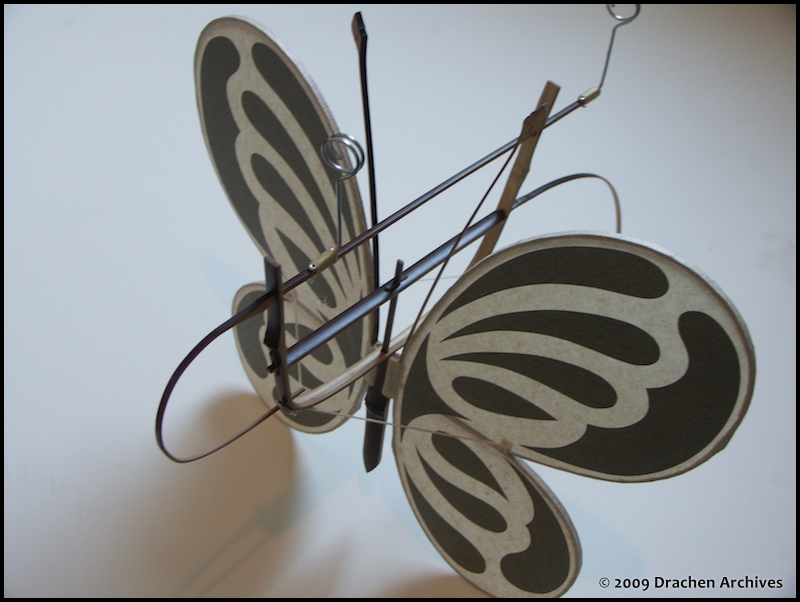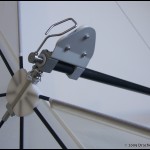Sitting on the ferry that travels from the Danish island of Fano, back to mainland Denmark, it was time to reflect on a few items in my kite collection that are not kites. Common in every kite culture are line-travelers, or ferries, that travel from the kite-flyer’s hand, up to the flying kite, and then back down to the flyer. In its simplest form, a ferry can be a torn piece of paper folded over the kite line; flying wind causes the paper to climb slowly up the line. I recently learned that in turn-of-the-20th-century Japan, they were called ‘monkeys’. A line-climbing monkey is depicted in the Soaring Kite sugoroku that I think is a wonderful documentation of mid-19th Century Japanese kites.
One of the most sophisticated I’ve seen was made by Andre Cassagne of France, flown proudly by Pete Dolphin; this mechanical masterpiece flies up the line, hits a stop and folds its wings, cruises down the kite line, hits a stop at the bottom causing the wings to pop back out, and then flies back up the line. Perpetual motion, kite-style!
Visiting old friends on Fano, I remembered how annoying I must have been when I first met Til Krapp. Til is the consummate German craftsman with brilliant ideas and the technology to carry them out. I first convinced Til and his friend Peter Malinski to trade his beautiful tetrahedral fittings for custom sails made by me. But later, I saw his wonderful ferry and had to have it! After fierce negotiations, Til ended up with kites from me, I ended up with the ferry you’ll see here. The pictures will tell more than I can, but the precision details are without match. It’s also a large ferry with a sail that’s over a meter wide and body that’s almost ½ meter long.
The second ferry that has been buried in my kite bag for a few years is a simple Chinese, silk and bamboo model. Featuring delicate painting and clever bamboo-work, this ferry shows the brilliance of traditional workmanship. A simple, over-center lock mechanism is all that holds the wings open, until a line-stop causes the wings to collapse and the ferry to return to sender. The use of bent needles, string, and carved bamboo is no less sophisticated than the high-tech plastic, stainless steel, and carbon fiber found in Til’s.
On a recent trip to Ishigaki Island in Japan, another ferry made its way to Colorado and my kite bag. Ishigaki is the southernmost island in the Okinawan chain and is as far away from the Okinawa Island as Okinawa is from the Japanese mainland. At one time in Japanese history, it was considered the end of the world.
At any rate, Ishigaki is known for its traditional butterfly ferries, common enough that they are sold in craft stores throughout the island and seen textiles and china. At the Japan Kite Association function that I attended, a young, island kite-enthusiast brought two wonderful contemporary ferries. Decorated in a very stylish manner and displaying fine traditional craftsmanship, this is a ferry that holds to tradition while pushing the art forward. Again, the details are sublime; bamboo wedges hold the structure together, antique bamboo complements the natural-color paper.
Scott Skinner







